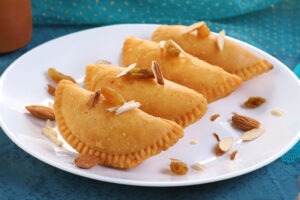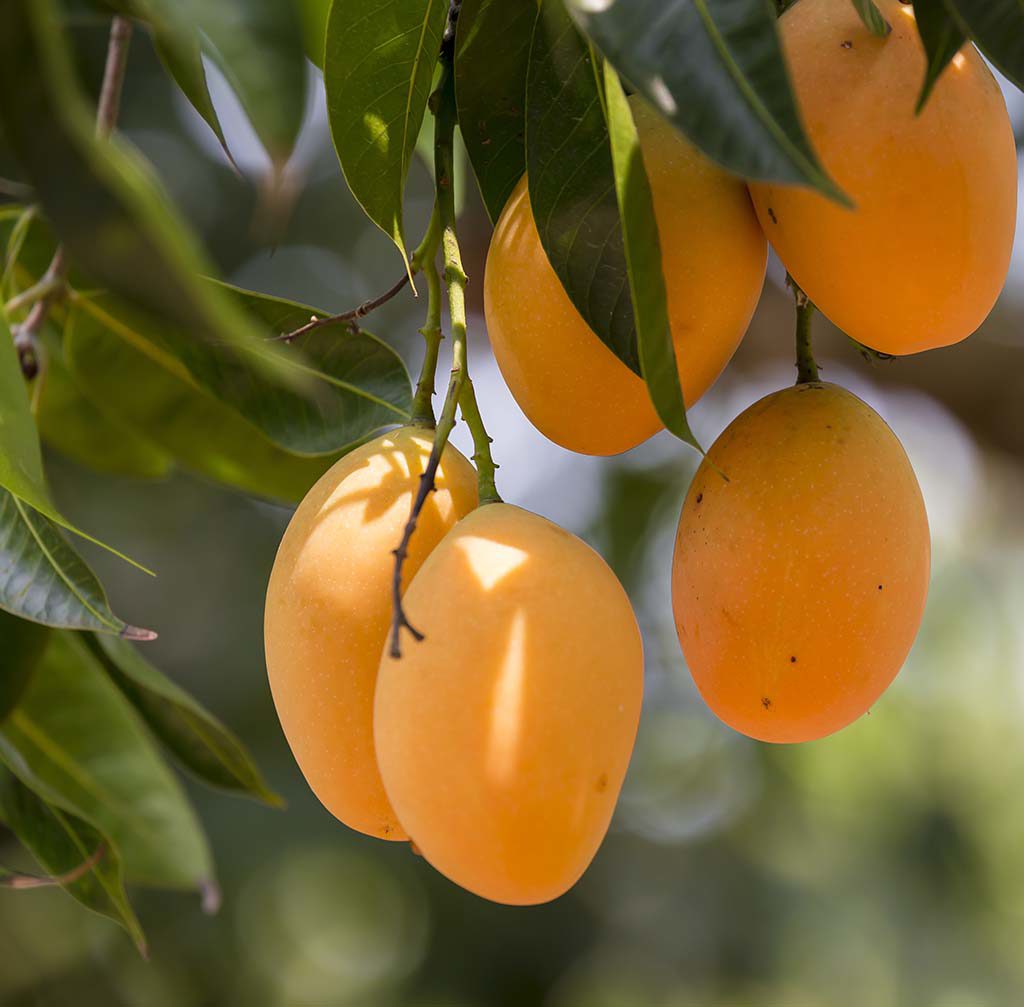 Mangoes – when they are yellow, you know they are ready. Some even turn reddish; they can be so sweet, juicy and satisfying to the palate. Even when mangoes are green they can be used and eaten in a variety of ways. A lot of people enjoy eating delicious mangoes and adore its diverse use but what exactly is a mango and what benefits do they have for you?
Mangoes – when they are yellow, you know they are ready. Some even turn reddish; they can be so sweet, juicy and satisfying to the palate. Even when mangoes are green they can be used and eaten in a variety of ways. A lot of people enjoy eating delicious mangoes and adore its diverse use but what exactly is a mango and what benefits do they have for you?
What is a Mango?
Mangoes are juicy stone fruit (drupe) from numerous species of tropical trees belonging to the flowering plant genus Mangifera, cultivated mostly for their edible fruit. The majority of these species are found in nature as wild mangoes. The genus belongs to the cashew family Anacardiaceae.
The ripe fruit varies in size, shape, color, sweetness, and eating quality. Cultivars are variously yellow, orange, red, or green, and carry a single flat, oblong pit that can be fibrous or hairy on the surface, and which does not separate easily from the pulp.
Mangoes may be somewhat round, oval, or kidney-shaped. The skin is leather-like, waxy, smooth, and fragrant, with color ranging from green to yellow, yellow-orange, yellow-red, or blushed with various shades of red, purple, pink or yellow when fully ripe.
Types of Mangoes
- Alphonso
- Chaunsa
- Dashehari
- Langra
- Safeda or Banganapalli
- Kesar
- Neelam
- Sindhri
- Keitt
- Gulab Khas
Guyanese Humor: Have you ever heard of “long bubby” mango?
Nutrients of the Mango
Mangoes provide calcium, iron, magnesium, and powerful antioxidants such as zeaxanthin, quercetin, astragalin and beta-carotene.
One cup of diced mangoes will give you:
- 100 calories
- 28 grams of carbohydrates
- 3 grams of fiber
- 8 grams of protein
- 46 milligrams of vitamin C (76 percent daily value (DV))
- 1262 IU of vitamin A (35 percent DV)
- 1 micrograms of folate (20 percent DV)
- 2 milligrams of vitamin B6 (11 percent DV)
- 8 milligrams of vitamin E (9 percent DV)
- 2 milligrams of copper (9 percent DV)
- 9 micrograms of vitamin K (8 percent DV)
- 257 milligrams of potassium (7 percent DV)
Health Benefits of the Mango
- Immune System can be boosted – Nutrients from the mango keeps your immune system healthy and strong.
- Heat Stroke can be fought – Juicing the fruit from green mango and mixing with water and a sweetener helps to cool down the body and prevent harm from overheating.
- Cancer can be prevented – Antioxidant compounds in mango fruit have been found to protect against colon, breast, leukemia and prostate cancers.
- Digestion can be improved – The fiber in mangoes also helps digestion and elimination.
- Cholesterol can be lowered – The high levels of fiber, pectin and vitamin C help to lower serum cholesterol levels, specifically Low-Density Lipoprotein.
- Skin can be cleared – Can be used both internally and externally for the skin. Mangoes help clear clogged pores and eliminate pimples.
- Eye Health can be improved – Nutrients in the mango promotes good eyesight and prevents night blindness and dry eyes.
- Blood sugar level can be lowered – Mango consumption has been linked to the lowering of blood sugar among obese adults.
- Blood pressure can be managed – Mangoes are rich in magnesium and potassium as well as low in sodium. So, this is a natural way to lower blood pressure.
- Bone health can be boosted – Mangoes contain good levels of bone-building vitamin K and also provides calcium, which is a major bone nutrient.
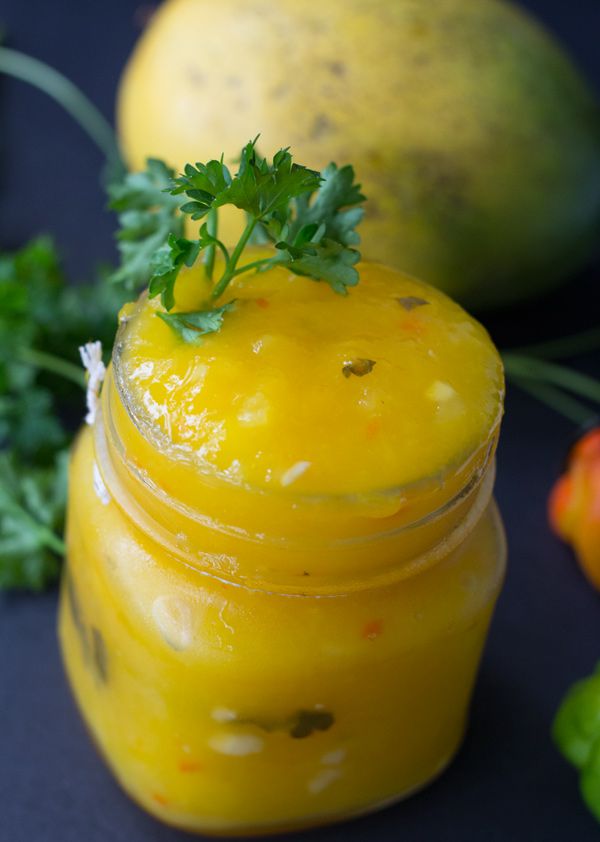
Mango Sour
Mangoes in Guyana
Mangoes are eaten and used in a variety of ways in Guyana. Here are some ways:
- The green mangoes can be used to make sour, achar or chutney.
Mango Sour
Ingredients:
- 2 full cups chopped mango
- 2 cloves garlic, chopped
- 1 scotch bonnet pepper, chopped
- 1 tablespoon chopped culantro (substitute with parsley)
- 1 tablespoon lime juice
- 1/4 tsp salt
- 1/4 tsp sugar
- 2 cups water
- 1 tablespoon vinegar (optional)
Method:
- Add mango, garlic, scotch bonnet pepper, culantro, lime juice, salt and sugar to a sauce pot
- Add water and mix together
- Bring mixture to a high boil and boil for 19 minutes
- Lower heat to simmer, stirring occasionally
- As mixture simmers, mash mango as it gets soft
- Simmer mixture till mango is a texture you desire, mashing as you stir (approximately 10 to 15 minutes)
- Taste for salt and pepper. If you desire more heat, add pepper sauce to liking
- Remove mixture from stove (sour will start to thicken up)
- Cool to about room temperature and add vinegar
- Serve at room temperature, or store in the fridge for later use.
Mango Achar
Ingredients:
-
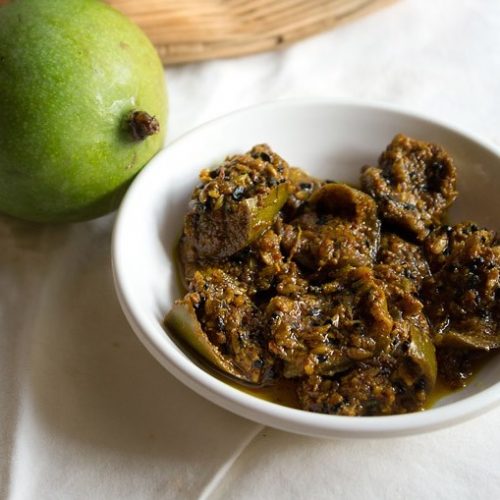
Mango Achar (Amchar) | Image Source: https://www.vegrecipesofindia.com/punjabi-mango-pickle/
16 young mangoes
- 1/3 cup salt
- 1 head garlic
- 1 1/2 cup oil
- 4 hot peppers (or more)
- 10 tbsp amchar masala
- 1 tsp salt
- 2 tbsp mustard oil (preservative)
Method:
- Wash the mangoes and cut off the tops
- Chop the mango in half lengthwise and remove the seed
- Cut up the mango lengthwise
- Add the salt, toss and leave overnight
- The next morning drain the salty water
- Dry with a towel
- Spread a cloth on the roof and place mango to dry
- The mangoes may take about two to three days depending on weather to dry
- After dried, heat the oil over a medium flame
- Cut up the hot pepper
- Add the pepper and garlic to the oil. Cook for about 1 minute
- Add the mango and amchar masala. Allow to cook for about 2 minutes stirring occasionally
- Turn off the flame, add mustard oil and salt.
Allow to cool and store in a large bottle in a cool place. After putting it in the bottle placed the mango achar back in the sun to dry a little more.
Ripe/yellow mangoes can make delicious juice.
Mango Juice
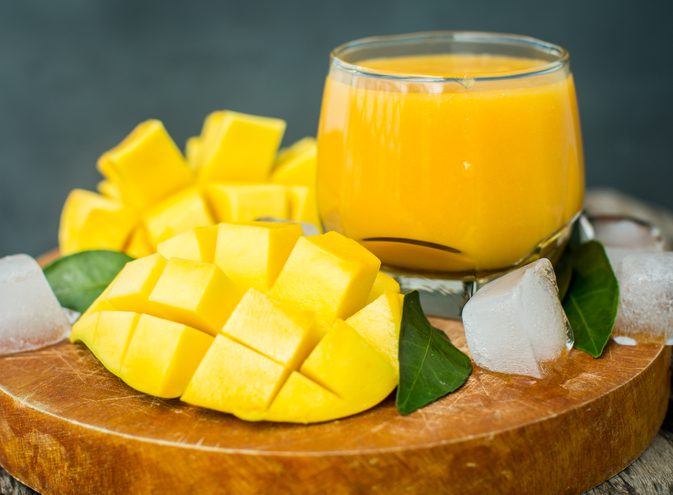
Mango Juice
Ingredients:
- 1 large mango peeled, cut into big chunks
- 1 tablespoon sugar
- 1 ½ cups chilled water
- Few ice cubes (optional)
Method:
- Wash, peel and chop the mango
- Put mango and sugar into blender
- Grind into puree
- Then add water and blend again
- Strain the juice and discard the fibrous pulp if any (optional)
- Keep refrigerated, chill until served.
Pickled Mangoes
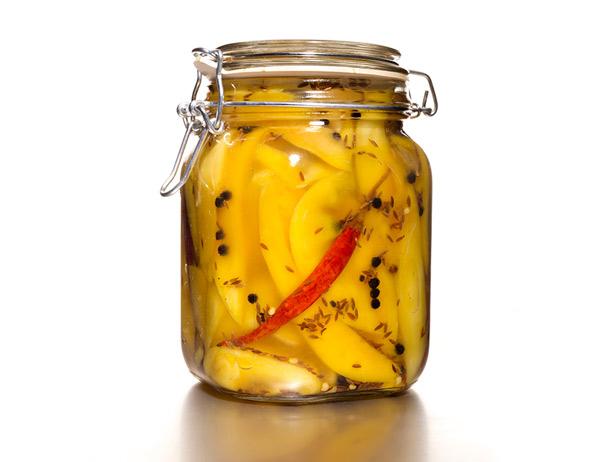
Pickled Mango | Image Source: https://www.foodnetwork.com/recipes/food-network-kitchen/pickled-mango-with-ginger-recipe-2112530
Ingredients:
- 5 unripe mangoes
- Salt
- Pepper
- Vinegar
- Sugar(white)
Method:
- Peel and slice mangoes
- Add salt, pepper and vinegar; toss and season for approximately 2 hours
- Pour in sugar(white). Mix thoroughly and let it sit for another 2 hours. You’ll see that the salt has drawn out the liquid from the fruit
- Pack in mason jar and pour in liquid
- Store for 2 days before eating.
Mangoes are found bountifully in Guyana; they are grown in the backyard of many, especially in the rural areas. A lot of mangoes can be found in the market and at the side of the road in tubs or in buckets being sold. Unripe and ripe mangoes are sold and consume; pickled mangoes are commonly sold in Guyana – vendors pass with baskets on their head selling pickled mangoes and it is also sold in the canteen of many schools. Mango sour and achar are especially enjoyed when eating snacks like pholourie, channa, eggball, cassava ball, puri, etc. As for the mango juice, it is sold at many juice outlets in Guyana or by the vendors in the market or who may pass in your neighborhood. A thirst-quenching juice outlet located in Guyana is called “Nicky’s Natural Fruit Juices and Ice-Cream”. Have a mango and enjoy it in whatever way is satisfying to your cravings!
Article References:
- http://www.guyanapremier.com/single-post/2017/06/01/Mango—The-Guyanese-Wonder-Fruit
- https://en.wikipedia.org/wiki/Mango
- https://www.mapsofindia.com/my-india/travel/in-search-of-your-favorite-mango
- https://listaka.com/top-10-mango-varieties-and-types-mango-list/
- https://draxe.com/mango-nutrition/
- https://www.homemadezagat.com/2016/08/guyanese-mango-sour.html
- https://www.spiceupthecurry.com/mango-juice-recipe/
- http://www.guyanapremier.com/single-post/2017/03/07/Guyanese-Mango-Achar
- https://snapguide.com/guides/make-pickled-mangoes/

